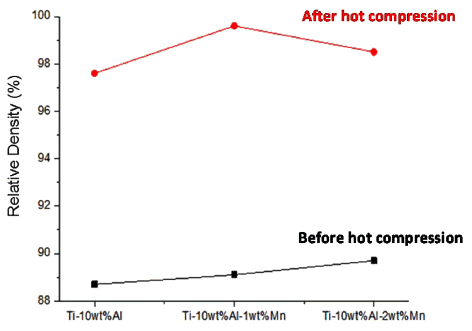Search
- Page Path
- HOME > Search
- [Korean]
- Effect of Mn Addition on Sintering Properties of Ti-10wt.%Al-xMn Powder Alloy
- Gi-Seung Shin, Yong-Taek Hyun, Nho-Kwang Park, Yong-Ho Park, Dong-Geun Lee
- J Korean Powder Metall Inst. 2016;24(3):235-241. Published online June 1, 2016
- DOI: https://doi.org/10.4150/KPMI.2017.24.3.235

- 581 View
- 2 Download
- 2 Citations
-
 Abstract
Abstract
 PDF
PDF Titanium alloys have high specific strength, excellent corrosion and wear resistance, as well as high heatresistant strength compared to conventional steel materials. As intermetallic compounds based on Ti, TiAl alloys are becoming increasingly popular in the aerospace field because these alloys have low density and high creep properties. In spite of those advantages, the low ductility at room temperature and difficult machining performance of TiAl and Ti3Al materials has limited their potential applications. Titanium powder can be used in such cases for weight and cost reduction. Herein, pre-forms of Ti-Al-xMn powder alloys are fabricated by compression forming. In this process, Ti powder is added to Al and Mn powders and compressed, and the resulting mixture is subjected to various sintering temperature and holding times. The density of the powder-sintered specimens is measured and evaluated by correlation with phase formation, Mn addition, Kirkendall void, etc. Strong Al-Mn reactions can restrain Kirkendall void formation in Ti-Al-xMn powder alloys and result in increased density of the powder alloys. The effect of Al-Mn reactions and microstructural changes as well as Mn addition on the high-temperature compression properties are also analyzed for the Ti-Al-xMn powder alloys.
-
Citations
Citations to this article as recorded by- Lattice Deformation and Improvement Oxidation Resistance of Ti-6Al-4V Alloy Powders Prepared by Hydrogen Added Argon Heat Treatment
Gye-Hoon Cho, Jung-Min Oh, Jae-Won Lim
Journal of Korean Powder Metallurgy Institute.2019; 26(2): 126. CrossRef - Effect of post heat treatment on fatigue properties of EBM 3D-printed Ti-6Al-4V alloy
Young-Sin Choi, Ji-Hoon Jang, Gun-Hee Kim, Chang-Woo Lee, Hwi-Jun Kim, Dong-Geun Lee
Journal of Korean Powder Metallurgy Institute.2018; 25(4): 340. CrossRef
- Lattice Deformation and Improvement Oxidation Resistance of Ti-6Al-4V Alloy Powders Prepared by Hydrogen Added Argon Heat Treatment
- [Korean]
- Characteristics of Porous Titanium Fabricated by Space-holder Method using NaCl
- Byoung-Hwi Son, Jae-Geun Hong, Yong-Taek Hyun, Seung-Eon Kim, Seok-Choun Bae
- J Korean Powder Metall Inst. 2011;18(6):488-495.
- DOI: https://doi.org/10.4150/KPMI.2011.18.6.488

- 646 View
- 6 Download
- 1 Citations
-
 Abstract
Abstract
 PDF
PDF - This study was performed to fabricate the porous titanium foam by space holder method using NaCl powder, and to evaluate the effect of NaCl volume fractions (33.3~66.6 vol.%) on the porosities, compressive strength, Young's modulus and permeability. For controlling pore size, CP titanium and NaCl particles were sieved to different size range of 70~150 µm and 300~425 µm respectively. NaCl of green Ti compact was removed in water followed by sintered at 1200°C for 2 hours. Total porosities of titanium foam were in the range of 38-70%. Pore shape was a regular hexahedron similar that of NaCl shape. Porous Ti body showed that Young's modulus and compressive strength were in the range of 0.6-6 GPa and 8-127 MPa respectively. It showed that pore size and mechanical properties of Ti foams was controllable by NaCl size and volume fractions.
-
Citations
Citations to this article as recorded by- Investigation on the Structural and Mechanical Properties of Al Foam Manufactured by Spark Plasma Sintering and Compression Molding Methods
Seunghyeok Choi, Sang-Hwa Lee, Jae-Gil Jung, Seok-Jae Lee, Tae-Young Ahn, Yu-Song Choi, Seung Bae Son
Korean Journal of Metals and Materials.2024; 62(7): 533. CrossRef
- Investigation on the Structural and Mechanical Properties of Al Foam Manufactured by Spark Plasma Sintering and Compression Molding Methods
TOP
 kpmi
kpmi


 First
First Prev
Prev


